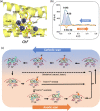Iron redox pathway revealed in ferritin via electron transfer analysis
- PMID: 32132578
- PMCID: PMC7055317
- DOI: 10.1038/s41598-020-60640-z
Iron redox pathway revealed in ferritin via electron transfer analysis
Abstract
Ferritin protein is involved in biological tissues in the storage and management of iron - an essential micro-nutrient in the majority of living systems. While there are extensive studies on iron-loaded ferritin, its functionality in iron delivery is not completely clear. Here, for the first time, differential pulse voltammetry (DPV) has been successfully adapted to address the challenge of resolving a cascade of fast and co-occurring redox steps in enzymatic systems such as ferritin. Using DPV, comparative analysis of ferritins from two evolutionary-distant organisms has allowed us to propose a stepwise resolution for the complex mix of concurrent redox steps that is inherent to ferritins and to fine-tune the structure-function relationship of each redox step. Indeed, the cyclic conversion between Fe3+ and Fe2+ as well as the different oxidative steps of the various ferroxidase centers already known in ferritins were successfully discriminated, bringing new evidence that both the 3-fold and 4-fold channels can be functional in ferritin.
Conflict of interest statement
The authors declare no competing interests.
Figures




Similar articles
-
Key carboxylate residues for iron transit through the prokaryotic ferritin SynFtn.Microbiology (Reading). 2021 Nov;167(11):001105. doi: 10.1099/mic.0.001105. Microbiology (Reading). 2021. PMID: 34825885 Free PMC article.
-
The ferritins: molecular properties, iron storage function and cellular regulation.Biochim Biophys Acta. 1996 Jul 31;1275(3):161-203. doi: 10.1016/0005-2728(96)00022-9. Biochim Biophys Acta. 1996. PMID: 8695634 Review.
-
Iron storage in bacteria.Adv Microb Physiol. 1998;40:281-351. doi: 10.1016/s0065-2911(08)60134-4. Adv Microb Physiol. 1998. PMID: 9889981 Review.
-
Bacterioferritin: Structure, Dynamics, and Protein-Protein Interactions at Play in Iron Storage and Mobilization.Acc Chem Res. 2017 Feb 21;50(2):331-340. doi: 10.1021/acs.accounts.6b00514. Epub 2017 Feb 8. Acc Chem Res. 2017. PMID: 28177216 Free PMC article.
-
The iron redox and hydrolysis chemistry of the ferritins.Biochim Biophys Acta. 2010 Aug;1800(8):719-31. doi: 10.1016/j.bbagen.2010.03.021. Epub 2010 Apr 9. Biochim Biophys Acta. 2010. PMID: 20382203 Review.
Cited by
-
Ultra-sensitive viral glycoprotein detection NanoSystem toward accurate tracing SARS-CoV-2 in biological/non-biological media.Biosens Bioelectron. 2021 Jan 1;171:112731. doi: 10.1016/j.bios.2020.112731. Epub 2020 Oct 15. Biosens Bioelectron. 2021. PMID: 33075725 Free PMC article.
-
Structural Rearrangement of Dps-DNA Complex Caused by Divalent Mg and Fe Cations.Int J Mol Sci. 2021 Jun 3;22(11):6056. doi: 10.3390/ijms22116056. Int J Mol Sci. 2021. PMID: 34205216 Free PMC article.
-
RNA-Seq Analysis Revealed the Virulence Regulatory Network Mediated by the Ferric Uptake Regulator (Fur) in Apostichopus japonicus Pathogenesis Induced by Vibrio splendidus.Microorganisms. 2025 May 22;13(6):1173. doi: 10.3390/microorganisms13061173. Microorganisms. 2025. PMID: 40572061 Free PMC article.
-
Vibrio splendidus Fur regulates virulence gene expression, swarming motility, and biofilm formation, affecting its pathogenicity in Apostichopus japonicus.Front Vet Sci. 2023 Jun 5;10:1207831. doi: 10.3389/fvets.2023.1207831. eCollection 2023. Front Vet Sci. 2023. PMID: 37342622 Free PMC article.
-
Structural and Biochemical Characterization of Silver/Copper Binding by Dendrorhynchus zhejiangensis Ferritin.Polymers (Basel). 2023 Mar 3;15(5):1297. doi: 10.3390/polym15051297. Polymers (Basel). 2023. PMID: 36904538 Free PMC article.

